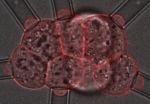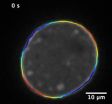Dancing with the cells
Cells 'dance' as they draw together during early embryo development
2015-06-16
(Press-News.org) The same kind of contraction that fires our muscles also controls a key stage of mammalian embryo development, according to a new study published in Nature Cell Biology. The research, conducted at EMBL Heidelberg, measured and mapped how cells in very early stage embryos bond tightly together. The scientists also discovered a cellular behaviour that hadn't been observed before: cells in the embryo 'dance', each one making the same rhythmic movement.
The focus of the study was a stage of development known as compaction, which takes place when the embryo has eight cells. Compaction changes the embryo from a loosely attached group of cells to a closely bonded single entity. During compaction - which takes around 10 hours - the cells change shape to create the overall form of the embryo, increasing the area of contact between them.
Using a new method, the researchers were able to measure the forces required to change the shape of the cells as compaction progressed.
Being able to chart the tension within the embryo without destroying it meant they were able to investigate which cellular process was the main driver behind the compaction process.
The first contender was a process known as adhesion. This is controlled by E-cadherin, an adhesion molecule on the cell surface that sticks cells together, 'zipping up' the two surfaces as the molecules attach to each other. Earlier research had shown that when adhesion was blocked, compaction did not take place.
The second contender was cell contraction, a process controlled by myosin, a type of motor protein that also causes contractions in muscle fibres. Myosin 'walks' on tracks formed by another protein, actin. Every cell has a layer of actin underneath its membrane, and myosin contracts this cortical layer, controlling the tension of the cell surface. The EMBL Heidelberg team had also established that compaction did not take place if a cell's ability to contract was blocked.
Postdoctoral researcher and first author, Jean-Léon Maître, explains: "By measuring the tensions of the cells when each cellular process was blocked, we were able to prove it was a contraction that pulls the cells together to compact the embryo, rather than adhesion acting as a glue to 'stick' them together. Adhesion is obviously important, but it appears to work as an anchor, rather than an engine of the compaction process."
This discovery was made possible by combining biological expertise from the group led by Takashi Hiiragi with that of the physicists working in the Nédéléc group.
Hervé Turlier explains: "The research showed that it was the increased tension at the outer surface of the embryo that drives the compaction, rather than the relaxation of the cell to cell contacts. In fact, the changing ratio between these two tensions now provides us with a simple way to portray the compaction process despite the complex biological mechanisms taking place."
At the same time as compaction but on a shorter timescale, the team observed that the cells start to 'dance'. The 'dance' is caused by a wave of contraction that bends the surface of the cell, traveling round it every 80 seconds.
"We've no idea at the moment if this 'dance' is important," says Hiiragi. "All we know is that it happens at the same time as compaction and is controlled by the same process."
Embryonic cells in other animals are known to pulse every 80 seconds, but this particular form of the movement hasn't been observed before. Further research will hopefully unveil the details underlying this peculiar phenomenon.
INFORMATION:
[Attachments] See images for this press release:


ELSE PRESS RELEASES FROM THIS DATE:
2015-06-16
In recent decades, enormous successes have been achieved in the field of public health. Three examples of these are the fight against HIV, the reduction in cardiovascular disease, and protection for non-smokers. For Germany to make even better use of the potential of public health, it needs more political support, improved research structures, and stronger international involvement. The German National Academy of Sciences Leopoldina, acatech - the National Academy of Science and Engineering, and the Union of the German Academies of Sciences and Humanities point this out ...
2015-06-16
Starfish have strange talents. Two biology students from University of Southern Denmark have revealed that starfish are able to squeeze foreign bodies along the length of their body cavities and out through their arm tips. This newly discovered talent gives insight into how certain animals are able to quickly heal themselves.
The two biology students, Frederik Ekholm Gaardsted Christensen and Trine Bottos Olsen have discovered a starfish behaviour that has never previously been described in the scientific literature. As part of their studies they were asked to tag some ...
2015-06-16
Chimpanzees and bonobos are the two closest living relatives of the human species - the ultimate tool-using ape. Yet, despite being so closely related on the evolutionary tree, wild chimpanzees and bonobos differ hugely in the way they use tools.
Chimpanzees show the most diverse range of tool use outside of humans. For example, chimpanzees use sticks to 'fish' for ants and termites, stones to crack nuts, as well as tools for grooming and communication. Bonobos rarely use tools and never to forage for food.
The question of 'what makes a tool user?' is a key one in ...
2015-06-16
AUSTIN, Texas -- Improving air quality -- in clean and dirty places -- could reduce pollution-related deaths worldwide by millions of people each year. That finding comes from a team of environmental engineering and public health researchers who developed a global model of how changes in outdoor air pollution could lead to changes in the rates of health problems such as heart attack, stroke and lung cancer.
Outdoor particulate air pollution results in 3.2 million premature deaths annually, more than the combined impact of HIV-AIDS and malaria. The researchers found that ...
2015-06-16
Lisbon, 16 June 2015: Despite a prevalence of anonymous sperm donation in European countries, the use of the same sperm donor for subsequent conceptions is of paramount importance to those couples needing sperm donation to have children. "We found a marked tendency to favour full genetic bonds where possible," said midwife Sara Somers presenting study results today at the Annual Meeting of ESHRE.
The study, performed by Ms Somers and colleagues at the Ghent University Hospital and Ghent University in Belgium, included 34 lesbian and heterosexual couples using sperm donation ...
2015-06-16
Lisbon, 16 June 2015: Dilatation and curettage (D&C) is one of the most common minor surgical procedures in obstetrics and gynaecology, used mainly for miscarriage or terminations.(1) Today, use of the 15-minute procedure is declining in favour of less invasive medical methods, but it still remains common in O&G.
Although D&C is generally considered safe and easy to perform, it is associated with some serious (if rare) side effects, including perforations to the cervix and uterus, infection, and bleeding. Now, an analysis 21 cohort studies which included almost 2 million ...
2015-06-16
Lisbon, 16 June 2015: It is a biological fact that female fertility declines with age - in assisted conception as in natural. Indeed, findings from a 12-year study reported today at the Annual Meeting of ESHRE by Dr Marta Devesa from the Hospital Universitaro Quiron-Dexeus in Barcelona, Spain, showed that in her own clinic cumulative live birth rates following IVF declined from 23.6% in women aged 38-39 years to 1.3% in those aged 44 and over.(1)
Such declines in success rate have been seen in many studies, but are not evident in older patients having egg donation to ...
2015-06-16
Lisbon, 16 June 2015: The risk of ectopic pregnancy following fertility treatment with assisted reproduction (ART) is small but significantly higher than found in natural conceptions. Now, a nationwide population-based analysis of all ART pregnancies achieved in the UK between 2000 and 2012 has found that the rate of ectopic pregnancy following IVF and ICSI progressively decreased throughout these 12 years, almost halving from an overall rate of 20 to 12 cases per thousand.
The results of the study are presented today at the Annual Meeting of ESHRE in Lisbon by Professor ...
2015-06-16
New research from the University of Copenhagen has found that maintaining a good night's sleep is important for our future health, partly because of how it affects lifestyle factors. Previous population based studies have not provided sufficient information on the timing of changes in both sleep and lifestyle to tease out cause and effect relations of this highly intertwined relationship.
"This study shows that sleep affects our ability to maintain a healthy lifestyle, and when sleep deteriorates we are more likely to make unhealthy lifestyle changes," says Postdoc Alice ...
2015-06-16
OAK BROOK, Ill. - A new MRI study has found distinct injury patterns in the brains of people with concussion-related depression and anxiety, according to a new study published online in the journal Radiology. The findings may lead the way to improved treatment and understanding of these common disorders, researchers said.
Post-concussion psychiatric disorders like depression, anxiety and irritability can be extremely disabling for those among the nearly 3.8 million people in the United States who suffer concussions every year. The mechanisms underlying these changes after ...
LAST 30 PRESS RELEASES:
[Press-News.org] Dancing with the cells
Cells 'dance' as they draw together during early embryo development




